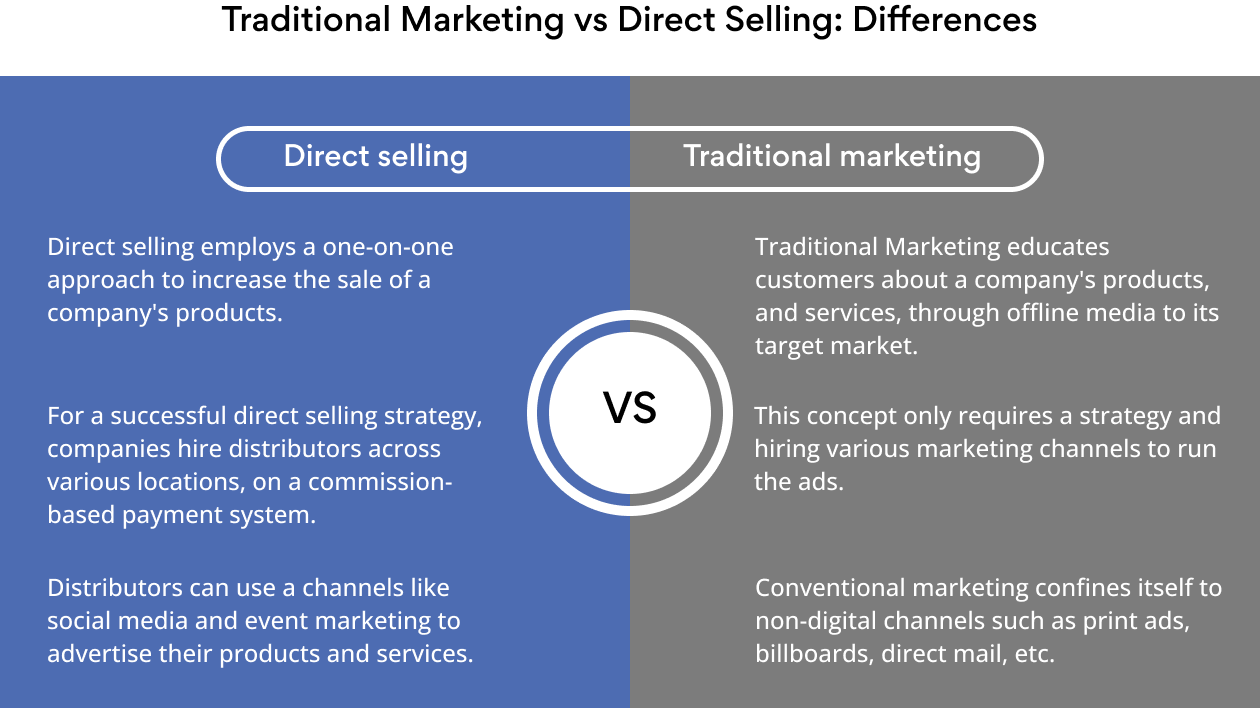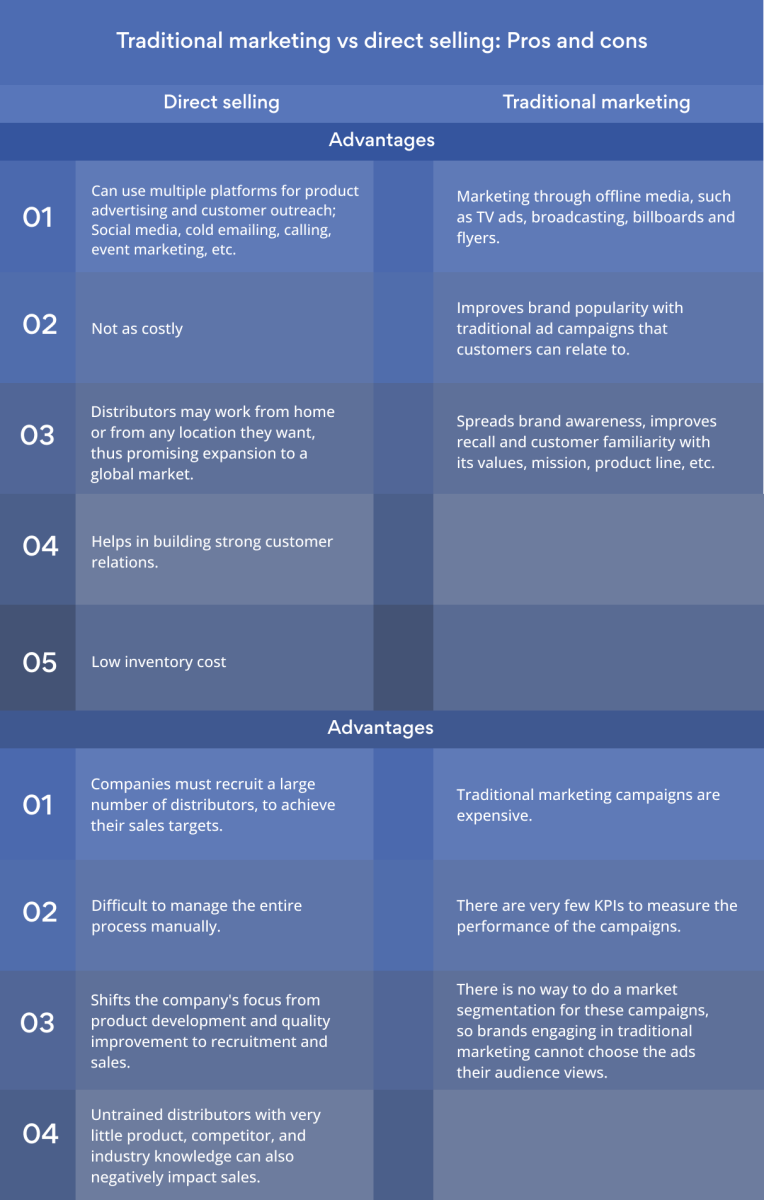Businesses today, work diligently to create selling strategies that are out-of-the-box and innovative. Stocking large inventories in fancy shops and showrooms to lure customers is definitely old times. Today, starting and maintaining lean is what businesses concentrate on. However, there is no scrimping in the marketing department. All the stops are pulled to have a strategy that will effectively position the product amidst the target customer base. To formulate such a strategy direct selling and traditional marketing are two ways that help indigenous companies and multinationals make their presence felt.
Introduction
Direct selling is all about selling products and services in a non-retail setting. It could be online, door-to-door, or any other approach.
While direct selling is often associated with network marketing or multi-level marketing and party-plan selling businesses, they are not the only ones deploying direct selling as a business strategy. Businesses across a wide range of industries implement direct selling to expand to a global market, and keep their sales team dynamic, remote and affordable.
Another popular and effective strategy for business is traditional marketing. The key idea behind this is to market products through an offline medium such as billboards, pamphlets, radio or television advertisements, etc.
While both concepts are hugely employed in the business industry, numerous factors must be considered before choosing the right strategy for your business.
Direct selling vs traditional marketing—which is right for your business? Let's find out.
What is direct selling for businesses?
Selling products and services without a mediator in a non-traditional retail setting (in-person or online) constitutes the concept of direct selling. It involves the company hiring representatives or distributors who can directly sell the products to the target customers. Products are sent directly to them instead of regional distribution centers or third-party retailers. These representatives or distributors shorten the circuitous route of sales when they are able to reach customers directly. They are recruited on a commission basis and earn a profit percentage from each sale.
Direct selling is usually preferred by companies looking for a flexible, low-investment sales strategy. This is so because it allows companies to eliminate the investment required for traditional sales and focus on expansion, globally.
According to the US Federal Trade Commission: "Direct selling is a blanket term that encompasses a variety of business forms premised on person-to-person selling in locations other than a retail establishment, such as social media platforms or the home of the salesperson or prospective customer."
Types of direct selling strategies
Direct selling is based on the D2C (Direct-to-Consumer) business model. It can be implemented in the form of single-level marketing, multi-level marketing, or party-plan sales.
Single level marketing: This is a form of sales that helps direct sellers earn profits purely from the sales of their products.
Multi-level marketing: Here the distributors earn a profitable income from the sales as well as from recruiting more distributors.
Party-plan sales: In this method social gatherings are organized and target customers are invited to attend to view and buy the products and services on display.
What is traditional marketing?
Until recently business had thrived on traditional marketing strategies. These would include offline campaigns to spread awareness about a business’s products and services amongst its target audience. The most relatable examples of this form of sales and marketing would be billboards, event marketing, cold calling, TV and radio commercials, and print ads. For comprehension’s sake, we could contrast it with the latest digital marketing. However, the latest has not completely ousted traditional marketing. It is being used by marketers to engage and interact with their customers physically.
An entrepreneur looking to launch a startup might wonder which would be the most delivering business model of the two forms — traditional business vs direct selling. After all, direct selling also encompasses digital marketing. The latter could be more affordable, agile and instantaneous. But, traditional marketing continues to charm customers. It helps businesses advertise their products to audiences located in the suburbs or villages with limited Internet access. Thus, it empowers brands to capture a broader range of customers, and improve margins. With a global market revenue of $234,58 billion in 2022, the traditional marketing sector is foreseen to achieve a CAGR of 5.52% by 2030.
Difference between traditional marketing and direct selling
There is a fine line between traditional marketing and direct selling. One is a marketing concept, while the latter is a sales tactic. As the name suggests, traditional marketing is a concept that educates customers about a product and its benefits through offline media. However, direct selling involves a brand’s hired sales representatives or distributors reaching out to their customers physically, minus the retail setting, of course.
Another notable difference between the two concepts is that direct selling requires companies to recruit distributors on a commission-based payment system. While traditional marketing only requires a strategy and hiring various marketing channels to run the ads.
Lastly, while traditional marketing sticks to spreading brand awareness through non-digital means, direct selling allows distributors to use various platforms (traditional or digital) such as social media, cold emails, calls, ads, etc, to sell their offerings.

Traditional marketing vs direct selling: Pros and cons for your business
Both direct selling and traditional marketing have numerous individual benefits that help businesses grow and improve their sales.
Advantages of traditional marketing
Reaching out to a wide audience: Television, radio, billboards, newspaper ads, etc, introduces the brand to new markets and simultaneously increases the customer base. Additionally, flyers and direct mail (such as newsletters and postcards) help attract a localized target market, ie. within a specific geographical location.
Brand longevity and popularity: Since traditional marketing is an expensive activity, customers associate the ad campaigns with brand success, growth, and popularity. The bigger the campaign—lasting the impression on its audience. This attracts consumers to the products, increasing the popularity and longevity of the brand.
Brand awareness: About 72% of customers engage with a brand when the campaign is tailored to their interests. Therefore, a customized ad campaign promotes immense exposure, and brand recall. It also increases the consumer's familiarity with the brand’s value, mission, vision, quality of products, and service. The customers’ trust in the brand catapults its long term sales exponentially.
Disadvantages of traditional marketing
Costly: Traditional marketing platforms such as TV ads and radio broadcasting are an expensive proposition. Additionally, producing and executing the ads adds to the expense list.
Low KPIs: There are no clear parameters to measure the performance of traditional marketing campaigns. Brands investing in traditional marketing are unable to understand how far their campaigns are working on their target audience.
Low market segmentation: Marketers are limited by traditional marketing approaches when segmenting their market to target a particular audience.
Discover how we build resilient businesses with advanced MLM functionalities
Advantages of direct selling
Inventory costs: Direct selling eliminates the need for businesses to maintain a physical store. This saves excess investment on inventory carrying costs and the expenses associated with running a brick-and-mortar location.
Innovative strategies: Direct selling offers businesses the flexibility to get creative with their customer outreach strategies. Through the direct selling approach distributors can engage customers through various channels, such as email marketing, event marketing, cold calls, etc. Many distributors also leverage social media to advertise their products. This approach enables them to reach a broader audience with minimal investment. Social media platforms help build a reliable community of followers and facilitate interactions with potential distributors and customers.
Reducing sales expenses: Direct selling ensures low sales expenditures for companies, leading to higher profits. This model reduces the need for traditional advertising and promotional activities.
Diverse and dynamic teams: A key advantage of direct selling is the opportunity to work with a diverse workforce from around the world. It allows distributors from various educational backgrounds to join, bringing dynamism and creativity to the business.
Global business growth: Direct selling facilitates business growth and expansion by connecting with a strong network of distributors and customers. This strategy enables companies to recruit distributors globally, enter international markets and tap the potential of numerous growing economies worldwide. Many companies also opt for network marketing, to expand their business rapidly.
Strong customer relations: Since direct selling also includes door-to-door, face-to-face sales, it helps establish a lasting relationship with the customers. Effective interaction with the customers improves their loyalty towards the brand, gathering helpful feedback on the service and quality of the product.
Disadvantages of direct selling
Undoubtedly, direct selling has advantages. Nevertheless, there are a few instances when companies face challenges in its implementation as a business model. Firstly, implementing a direct sales strategy requires recruiting of a large network of distributors. This often shifts the focus from product development to quality check.
Secondly, distributors interacting with the customers must have ample product and sales knowledge to handle questions and objections. Lastly, the commission-based system is an unwieldy process. It cannot be managed without a direct selling software that keeps a strict account of the sales, distributor recruitment, outflow of the products, profits, and more.

Conclusion
Direct selling is a booming industry, generating millions of job opportunities for people around the world. In 2022, the sector generated around $173 billion globally, out of which approximately $42 billion was the annual revenue generated by the US. Global leaders like Amway, Avon Cosmetics, and Herbalife Nutrition have successfully adopted the direct selling strategy to augment their sales and profits. That said, brands like Coca-Cola, Nike, Pepsi, and Old Spice have achieved high ROIs and customer engagement with their traditional marketing campaigns for decades.
Both business models deliver results depending on the environment they are being implemented in. Conditions that influence their success include the type of market in which the product is to be launched, target customers, volume of investment and more. In the debate of direct selling vs traditional marketing, the deciding factors would be the state of market conditions.









Leave your comment
Fill up and remark your valuable comment.